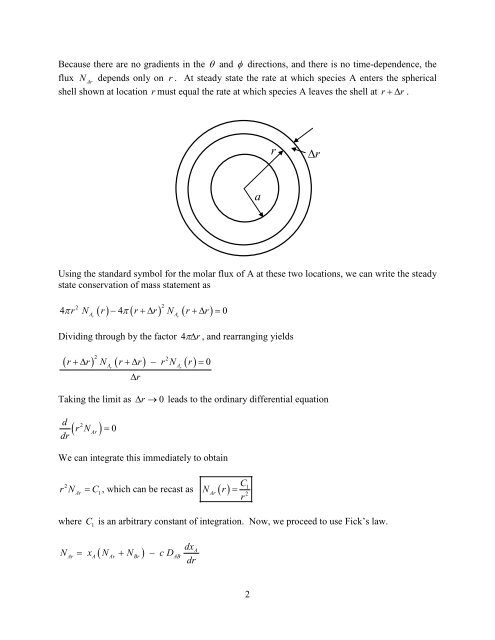Mass Transfer Between a Sphere and an Unbounded Fluid ( )
Mass Transfer Between a Sphere and an Unbounded Fluid ( )
Mass Transfer Between a Sphere and an Unbounded Fluid ( )
Create successful ePaper yourself
Turn your PDF publications into a flip-book with our unique Google optimized e-Paper software.
Because there are no gradients in the θ <strong><strong>an</strong>d</strong> φ directions, <strong><strong>an</strong>d</strong> there is no time-dependence, the<br />
flux N<br />
Ar<br />
depends only on r . At steady state the rate at which species A enters the spherical<br />
shell shown at location r must equal the rate at which species A leaves the shell at r+∆ r .<br />
r<br />
∆r<br />
a<br />
Using the st<strong><strong>an</strong>d</strong>ard symbol for the molar flux of A at these two locations, we c<strong>an</strong> write the steady<br />
state conservation of mass statement as<br />
2<br />
( ) π ( ) ( )<br />
πr N r − r+∆ r N r+∆ r =<br />
2<br />
4<br />
A<br />
4 0<br />
r<br />
Ar<br />
Dividing through by the factor 4π∆ r , <strong><strong>an</strong>d</strong> rearr<strong>an</strong>ging yields<br />
( r r) 2 N ( r r) r 2 N ( r)<br />
+∆<br />
A<br />
+∆ − 0<br />
r<br />
A<br />
=<br />
r<br />
∆r<br />
Taking the limit as ∆r<br />
→ 0 leads to the ordinary differential equation<br />
d<br />
rNAr<br />
dr<br />
2<br />
( )<br />
= 0<br />
We c<strong>an</strong> integrate this immediately to obtain<br />
2<br />
rNAr<br />
C1<br />
= C1<br />
, which c<strong>an</strong> be recast as NAr<br />
( r) =<br />
2<br />
r<br />
where C<br />
1<br />
is <strong>an</strong> arbitrary const<strong>an</strong>t of integration. Now, we proceed to use Fick’s law.<br />
dx<br />
( )<br />
A<br />
NAr = xA NAr + NBr − cDAB<br />
dr<br />
2

















